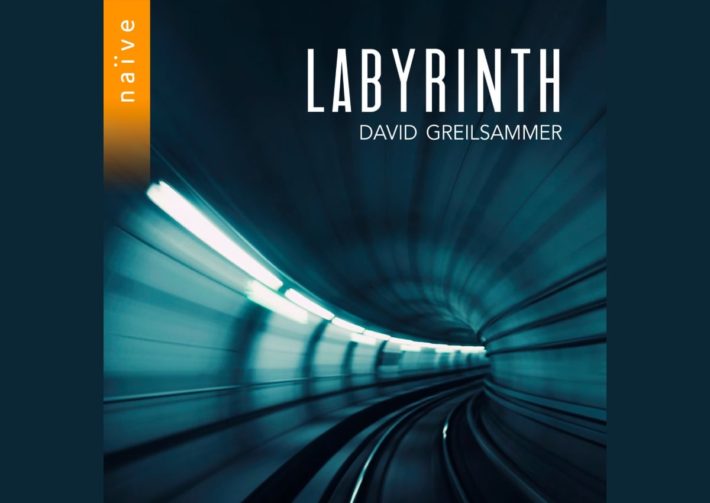David Greilsammer’s latest release draws its inspiration from a recurring dream where he stands in an infinite labyrinth. The album embodies both the vision (“this dream, or this nightmare”) and structure (“a remarkable edifice”) in innovative ways. The first is in the choice of the pieces, which reflects the maze as a large architectural form: small groups of selections (in which one composer bookends another of a different era and style) surround one central work that stands alone. Within each group, however, is also a smaller maze of sorts that lets us appreciate individual selections in an unconventional context.
Greilsammer’s pairing of Beethoven’s Op. 126 Bagatelles with George Crumb’s Makrokosmos (tracks 4-6) is intriguing: he doesn’t hold back in bagatelle No. 4 (track 4), though the fierce drive and overpowering accents occasionally results in a heavy feel. This does contrast effectively with the more playful sections of jazzy, syncopated rhythms, though. (As far as comparisons go, I do prefer Paul Lewis’ take from his 2019 Harmonia Mundi release – it maintains the intensity of the sforzandos and the syncopation but is more stylistically refined.) The Magic Circle of Infinity (track 5) cleverly adds a visual element to the album’s theme. In the score itself, the staves are shaped into a circle – a striking visualization of a labyrinth. Greilsammer’s performance here is convincing: the sound clusters create eerie sonoric veils but individual notes come through in a crystalline and pristine fashion. If we listen closely, we can perceive a connection to the previous Beethoven track: the presence of rhythmic patterns pierce through the floating resonances. The Op. 126 No. 5 bagatelle (track 6) is a transition to a calming dream. In the context of the dark and nebulous world from whence we just came, we appreciate even more the beautiful simplicity of the opening melodic line. This interpretation fares quite a bit better than No. 4, with the pianist adding lovely touches in moments when he brings out the left hand’s hidden middle voices.
Another interesting grouping features two Ligeti etudes with Contrapunctus 1 of Bach’s Art of Fugue. In Fanfares (track 7), there is seamless consistency and control in the ever-present scale patterns; this subsequently brings the other rhythmic and harmonic patterns forward as they help build the etude’s complexity and intensity. Contrapunctus 1 (track 8) is a moment of clarity in the labyrinth: where the different voices in Fanfares become increasingly tumultuous, in the Bach, they come together in harmonious conversation. Greilsammer’s clean performance provides a moment of reset and respite before En suspens (track 9), a return to a more complex part of the maze. En suspens is in some ways a synthesis of the two preceding works: at its heart is a tonal lullaby-like melody. When intertwined with the accompanying dissonances, we get an ever-morphing kaleidoscope of harmonic colors, something the pianist makes even more vibrant with a bell-like tone quality.
Related Classical Music Reviews
- Album Review: c.1300-c.2000 – Jeremy Denk, Piano
- Double Review: Khatia Buniatishvili – “Labyrinth”, Bertrand Chamayou – “Good Night!”
- Review: “Encounter” – Igor Levit, Piano
The centerpiece of the labyrinth is Granados’ El Amor y la muerta (track 10). Greilsammer is at his best in the softer moments, which are quite poetic: he not only takes his time to reflect but also allows us to savor the meandering melodies. However, the more impassioned sections can sound a bit forced and stringent – the beginning, for instance, seems hurried where it could be more declamatory.
One of the most dramatic juxtapositions between dream and nightmare exists in the final pairing of Scriabin with Rebel’s “Le Chaos”. Nuances (track 17) has a fluidity that evokes a languorous character; Greilsammer’s well-placed dynamic contrasts add elements of a dream-like fantasy. The gentleness of the work is in fact what makes the opening of le chaos (track 18) jarring and certainly unexpected: the opening chords with their terrifying dissonances seem like part of a much more contemporary work. Vers la flamme (track 19) leaves us wandering in the labyrinth with the chilling mysticism that was a signature of Scriabin’s late works.
The sound engineering makes the piano seem up close, especially where the louder dynamics comes through a bit abrasively, but it otherwise captures its warmer colors. The liner notes, containing the performer’s pensive musings and some descriptions of the pieces, are curious and insightful.
Though the choice of works might initially seem like an enigma, Greilsammer’s largely convincing performances illuminate nuanced connections. This album is a thought-provoking listen and a worthy example of creative programming.

“Labyrinth”
David Greilsammer – Piano
naïve, CD V7084
Recommended Comparisons
Read more classical music reviews or visit The Classic Review Amazon store
Follow Us and Comment:
Get our periodic classical music newsletter with our recent reviews, news and beginners guides.
We respect your privacy.









